park assist GMC YUKON DENALI 2003 Owners Manual
[x] Cancel search | Manufacturer: GMC, Model Year: 2003, Model line: YUKON DENALI, Model: GMC YUKON DENALI 2003Pages: 447, PDF Size: 21.97 MB
Page 119 of 447
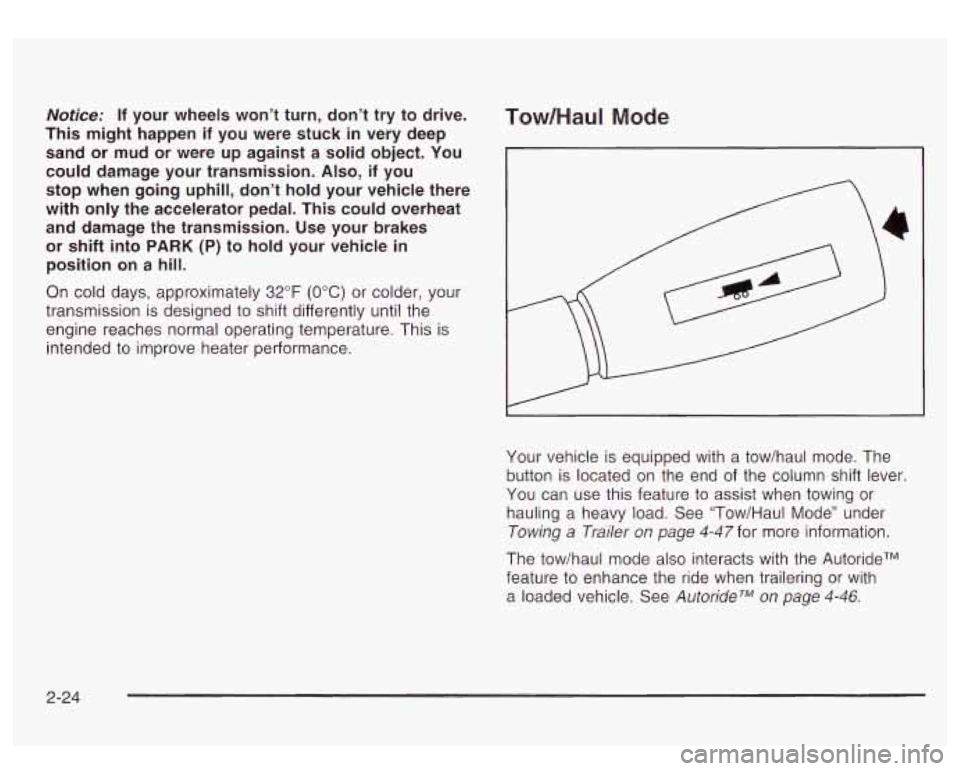
Notice: If your wheels won’t turn, don’t try to drive.
This might happen
if you were stuck in very deep
sand or mud or were up against
a solid object. You
could damage your transmission. Also, if you
stop when going uphill, don’t hold your vehicle there
with only the accelerator pedal. This could overheat
and damage the transmission. Use your brakes
or shift into
PARK (P) to hold your vehicle in
position on
a hill.
On cold days, approximately
32°F (OOC) or colder, your
transmission is designed
to shift differently until the
engine reaches normal operating temperature. This is
intended
to improve heater performance.
Tow/HauI Mode
Your vehicle is equipped with a tow/haul mode. The
button is located on the end
of the column shift lever.
You can use this feature
to assist when towing or
hauling a heavy load. See “Tow/Haul Mode” under
Towing
a Trailer on page 4-47 for more information.
The tow/haul mode also interacts with the AutorideTM
feature
to enhance the ride when trailering or with
a loaded vehicle. See AutorideTM on page
4-46.
2-24
Page 130 of 447
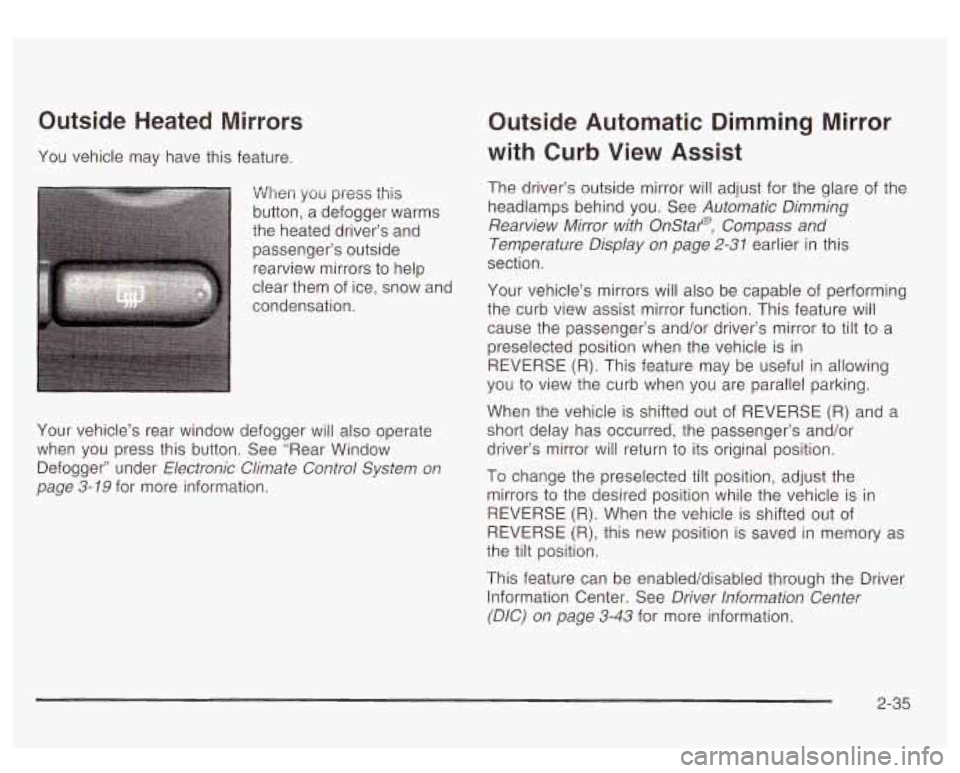
Outside Heated Mirrors
You vehicle may have this feature.
When you press this
button, a defogger warms
the heated driver’s and passenger’s outside rearview mirrors
to help
clear them of ice, snow and
condensation.
Your vehicle’s rear window defogger will also operate
when you press this button. See “Rear Window
Defogger” under Electronic Climate Control System on
page
3-79 for more information.
Outside Automatic Dimming Mirror
with Curb View Assist
The driver’s outside mirror will adjust for the glare of the
headlamps behind you. See Automatic Dimming
Rearview Mirror with OnStap, Compass and
Temperature Display on page
2-31 earlier in this
section.
Your vehicle’s mirrors will also be capable of performing
the curb view assist mirror function. This feature will
cause the passenger’s and/or driver’s mirror
to tilt to a
preselected position when the vehicle is in
REVERSE
(R). This feature may be useful in allowing
you
to view the curb when you are parallel parking.
When the vehicle is shifted out of REVERSE
(R) and a
short delay has occurred, the passenger’s and/or
driver’s mirror will return
to its original position.
To change the preselected tilt position, adjust the
mirrors
to the desired position while the vehicle is in
REVERSE
(R). When the vehicle is shifted out of
REVERSE
(R), this new position is saved in memory as
the tilt position.
This feature can be enabled/disabled through the Driver
lnformation Center. See Driver lnformation Center
@IC) on page
3-43 for more information.
2-35
Page 180 of 447
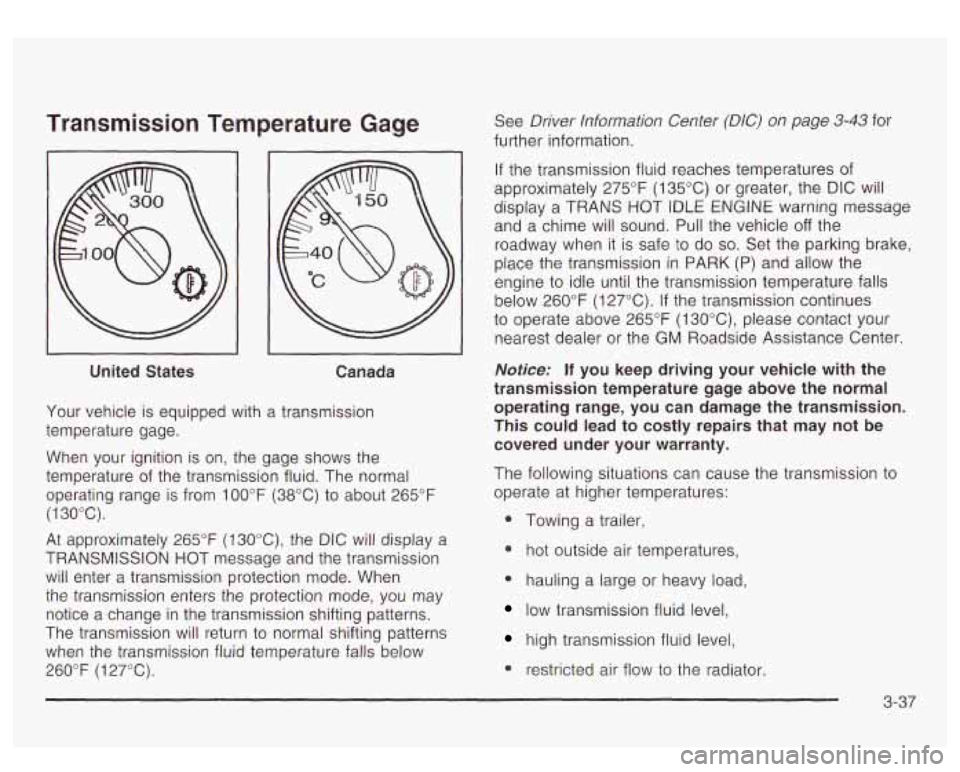
Transmission Temperature Gage
--
United States Canada
Your vehicle is equipped with a transmission
temperature gage.
When your ignition is on, the gage shows the
temperature of the transmission fluid. The normal
operating range is from
100°F (38°C) to about 265°F
(1 30°C).
At approximately 265°F (130°C), the DIC will display a
TRANSMISSION HOT message and the transmission
will enter a transmission protection mode. When
the transmission enters the protection mode, you may
notice a change in the transmission shifting patterns.
The transmission will return to normal shifting patterns
when the transmission fluid temperature falls below
260°F
(1 27°C). See
Driver Information
Center (DIC) on page 3-43 for
further information.
If the transmission fluid reaches temperatures of
approximately 275°F (135°C) or greater, the DIC will
display a TRANS
HOT tDLE ENGtNE warning message
and a chime will sound. Pull the vehicle
off the
roadway when it is safe
to do so. Set the parking brake,
place the transmission in PARK
(P) and allow the
engine to idle until the transmission temperature falls
below 260°F (127°C).
If the transmission continues
to operate above 265°F
(1 30"C), please contact your
nearest dealer or the
GM Roadside Assistance Center.
Notice: If you keep driving your vehicle with the
transmission temperature gage above the normal
operating range, you can damage the transmission.
This could lead to costly repairs that may not be
covered under your warranty.
The following situations can cause the transmission to
operate at higher temperatures:
0 Towing a trailer,
* hot outside air temperatures,
0 hauling a large or heavy load,
low transmission fluid level,
high transmission fluid level,
0 restricted air flow to the radiator.
Page 282 of 447
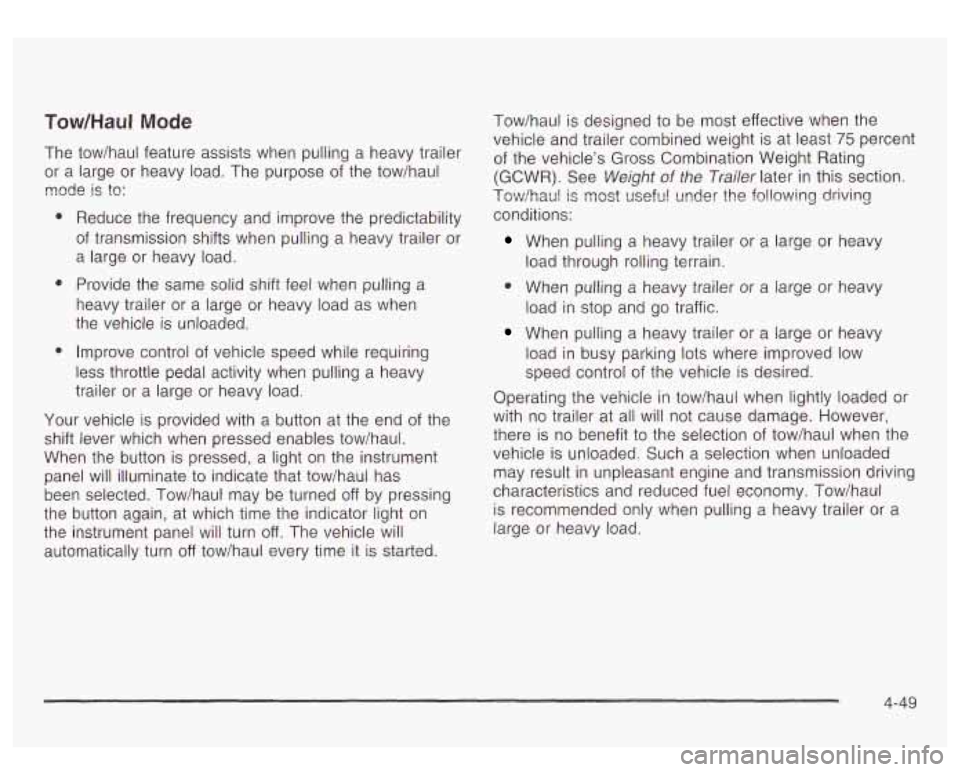
Tow/Haul Mode
The tow/haul feature assists when pulling a heavy trailer
or a large or heavy load. The purpose
of the tow/haul
mode
is to:
Reduce the frequency and improve the predictability
of transmission shifts when pulling a heavy trailer or
a large or heavy load.
Provide the same solid shift feel when pulling a
heavy trailer or a large or heavy load as when
the vehicle is unloaded.
Improve control of vehicle speed while requiring
less throttle pedal activity when pulling a heavy
trailer or a large or heavy load.
Your vehicle is provided with a button at the end of the
shift lever which when pressed enables tow/haul.
When the button is pressed, a light on the instrument
panel will illuminate
to indicate that tow/haul has
been selected. Tow/haul may be turned
off by pressing
the button again, at which time the indicator light on
the instrument panel will turn off. The vehicle will
automatically turn off tow/haul every time it is started. Tow/haul
is designed
to be most effective when the
vehicle and trailer combined weight is at least
75 percent
of the vehicle’s Gross Combination Weight Rating
(GCWR). See Weight
of the Trailer later in this section.
Tovdhaul is mcst useful wder the f~l!~~ing driving
conditions:
When pulling a heavy trailer or a large or heavy
0 When pulling a heavy trailer or a large or heavy
load through rolling terrain.
load
in stop and go traffic.
When pulling a heavy trailer or a large or heavy
load in busy parking
lots where improved low
speed control of the vehicle is desired.
Operating the vehicle in tow/haul when lightly loaded or
with no trailer at all will not cause damage. However,
there is no benefit
to the selection of tow/haul when the
vehicle is unloaded. Such a selection when unloaded may result in unpleasant engine and transmission driving
characteristics and reduced fuel economy. Tow/haul
is recommended only when pulling a heavy trailer or a
large or heavy load.
4-49
Page 426 of 447
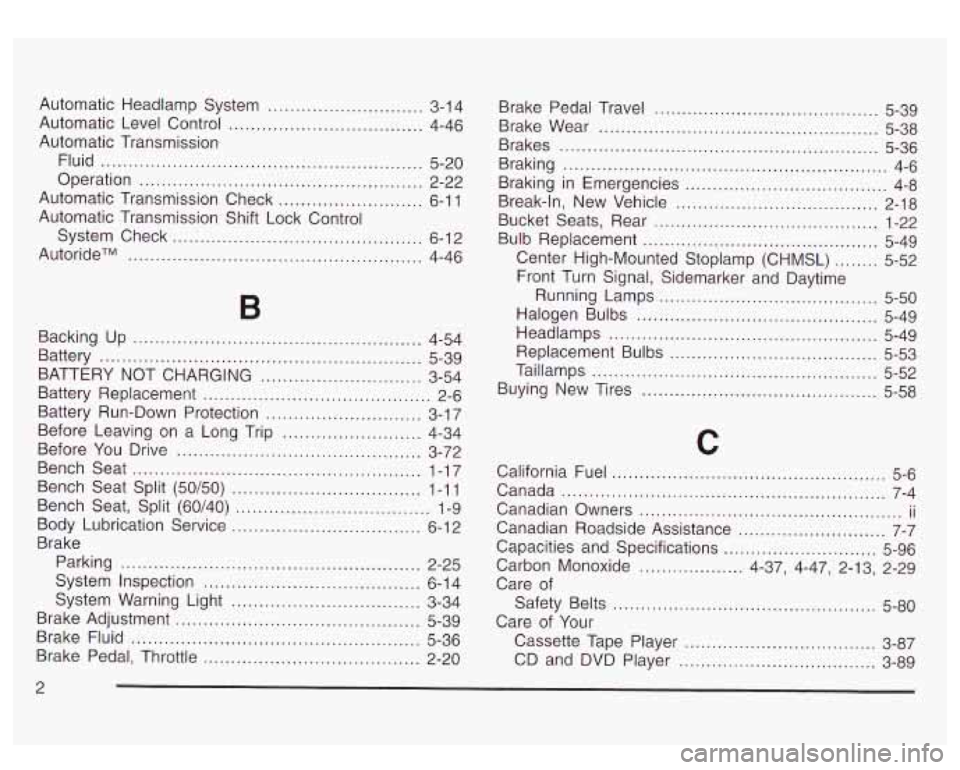
Automatic Headlamp System ............................ 3-1 4
Automatic Level Control
................................... 4-46
Automatic Transmission Fluid
.......................................................... 5-20
Operation
................................................... 2-22
Automatic Transmission Check
.......................... 6-1 1
Automatic Transmission Shift Lock Control
System Check
............................................. 6-12
AutorideTM
................................................. 4-46
B
Backing Up .................................................... 4-54
Battery
.......................................................... 5-39
Battery Replacement
......................................... 2-6
Battery Run-Down Protection
............................ 3-1 7
Before You Drive
............................................ 3-72
Bench Seat
.................................................... 1-17
Bench Seat Split (50/50)
.................................. 1-1 1
Bench Seat, Split (60/40)
................................... 1-9
Body Lubrication Service
.................................. 6-12
Brake
Parking
...................................................... 2-25
System Inspection
....................................... 6-1 4
BATTERY NOT
CHARGING
............................. 3-54
Before Leaving on a Long Trip
......................... 4-34
System Warning Light
.................................. 3-34
Brake
Brake
Brake
2 Adjustment
............................................ 5-39
Fluid
.................................................... 5-36
Pedal. Throttle
....................................... 2-20 Brake Pedal Travel
......................................... 5-39
Brake Wear
................................................... 5-38
Brakes
.......................................................... 5-36
Braking
........................................................... 4-6
Braking in Emergencies
..................................... 4-8
Break-in, New Vehicle
..................................... 2-18
Bucket Seats, Rear
......................................... 1-22
Bulb Replacement
........................................... 5-49
Center High-Mounted Stoplamp (CHMSL)
........ 5-52
Front Turn Signal, Sidemarker and Daytime
Halogen Bulbs
............................................ 5-49
Headlamps
................................................. 5-49
Replacement Bulbs
...................... ........ 5-53
Taillamps
........................................ .... 5-52
Buying New Tires
....................................... 5-58
Running Lamps
........................................ 5-50
C
California Fuel ................................. .......... 5-6
Canada
........................................................... 7-4
Canadian Owners
................................................ ii
Canadian Roadside Assistance ........................... 7-7
Capacities and Specifications ............................ 5-96
Carbon Monoxide
................... 4-37, 4-47, 2.13, 2-29
Care
of
Safety Belts ............................. .... 5-80
Care
of Your
Cassette Tape Player
............................... 3-87
CD and DVD Player .................................... 3-89
Page 434 of 447
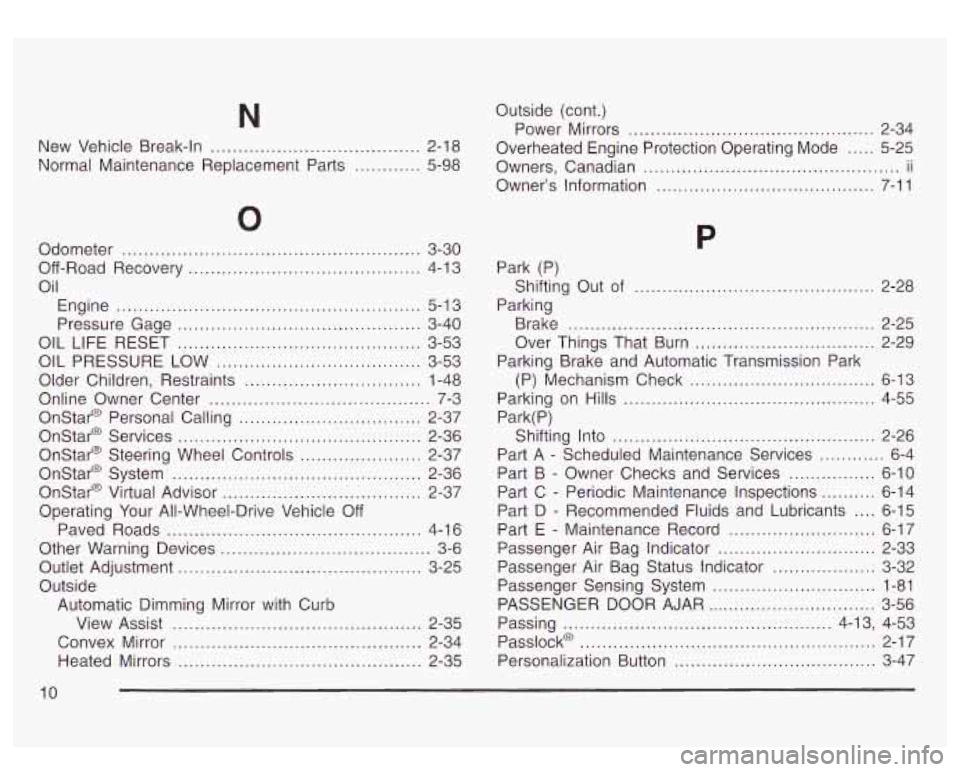
........... 3-30
....... 4-13
New
Vehicle Break-In
...................................... 2-18
Normal Maintenance Replacement Parts
............ 5-98
0
Odometer ................................
Oil Off-Road Recovery
............
Engine .............. .............. 5-13
Pressure Gage
.......... .................. 3-40
OIL LIFE RESET ............................................ 3-53
OIL PRESSURE LOW
..................................... 3-53
Older Children. Restraints
................................ 1-48
Online Owner Center
........................................ 7-3
Onstar@ Personal Calling
................................. 2-37
Onstar@ Services
............................................ 2-36
Onstar@ Steering Wheel Controls
...................... 2-37
Onstar@ System
............................................. 2-36
Onstar@ Virtual Advisor
.................................... 2-37
Operating Your All-Wheel-Drive Vehicle
Off
Paved Roads .............................................. 4-1 6
Other Warning Devices
...................................... 3-6
Outlet Adjustment
............................................ 3-25
Outside Automatic Dimming Mirror with Curb
View Assist
............................................. 2-35
Convex Mirror
............................................. 2-34
Heated Mirrors
............................................ 2-35 Outside
(cont.)
Power Mirrors
............................................. 2-34
Overheated Engine Protection Operating Mode
..... 5-25
Owners. Canadian
............................................... ii
Owner’s Information
........................................ 7-11
P
Park (P)
Parking Shifting Out
of
............................................ 2-28
Brake
........................................................ 2-25
Over Things That Burn
................................. 2-29
Parking Brake and Automatic Transmission Park
(P) Mechanism Check
.................................. 6-13
Parking on Hills .............................................. 4-55
Park( P)
Shifting Into
................................................ 2-26
Part
A - Scheduled Maintenance Services ............ 6-4
Part B
- Owner Checks and Services ................ 6-10
Part C
- Periodic Maintenance Inspections .......... 6-14
Part
D - Recommended Fluids and Lubricants .... 6-15
Part E
- Maintenance Record ........................... 6-17
Passenger Air Bag Indicator
............................. 2-33
Passenger Sensing System
.......................... 1-81
PASSENGER
DOOR AJAR ........ ............ 3-56
Passing
............................................. 4-13, 4-53
Passlock@
...................................................... 2-17
Personalization Button
..................................... 3-47
Passenger
Air Bag Status Indicator
................... 3-32
10
Page 436 of 447
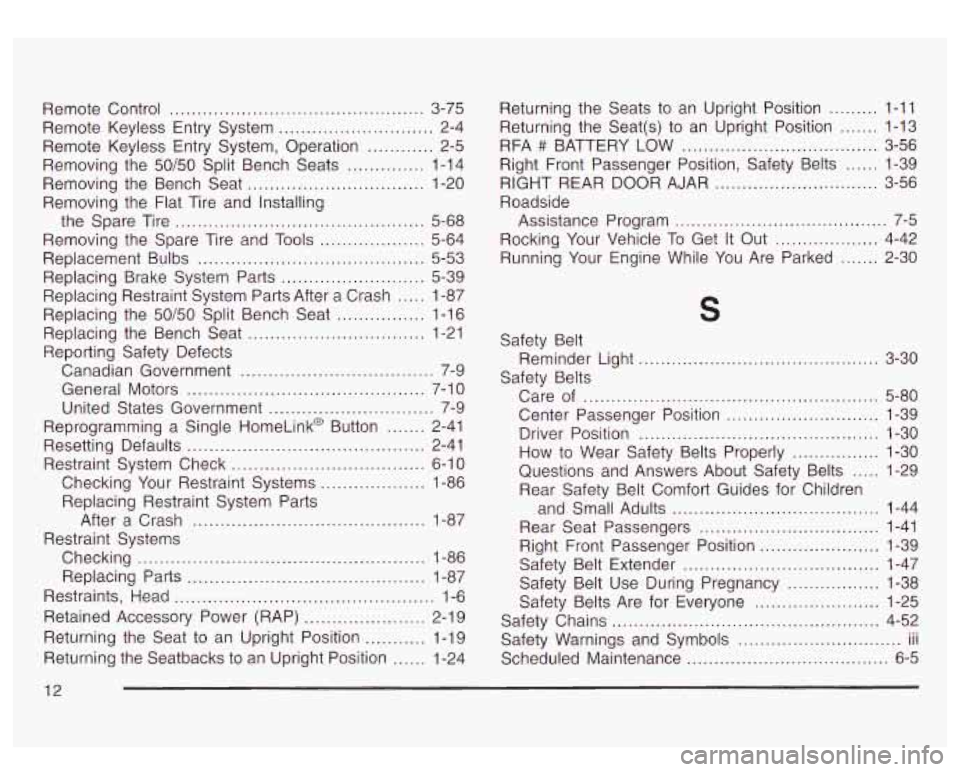
Remote Control .............................................. 3-75
Remote Keyless Entry System
............................ 2-4
Remote Keyless Entry System. Operation
............ 2-5
Removing the 50/50 Split Bench Seats
.............. 1-14
Removing the Bench Seat
................................ 1-20
Removing the Flat Tire and Installing
Removing the Spare Tire and Tools
................... 5-64
Replacement Bulbs
......................................... 5-53
Replacing Restraint System Parts After a Crash
..... 1-87
Replacing the Bench Seat
................................ 1-21
Reporting Safety Defects
Canadian Government
................................... 7-9
General Motors
........................................... 7-1 0
United States Government .............................. 7-9
Reprogramming a Single HomeLink@ Button
....... 2-41
Resetting Defaults
........................................... 2-41
Restraint System Check
................................... 6-10
Checking Your Restraint Systems
................... 1-86
Replacing Restraint System Parts
After a Crash
.......................................... 1-87
Checking
.................................................... 1-86
Restraints, Head
............................................... 1-6
Retained Accessory Power (RAP)
...................... 2-19
Returning the Seat to an Upright Position
........... 1-19
Returning the Seatbacks to an Upright Position
...... 1-24
the Spare
Tire
............................................. 5-68
Replacing Brake System Parts
.......................... 5-39
Replacing the
50/50 Split Bench Seat ................ 1-16
Restraint Systems
Replacing Parts
........................................... 1-87 Returning
the Seats to an Upright Position
......... 1-11
Returning the Seat(s) to an Upright Position
....... 1-13
RFA
# BATTERY LOW .................................... 3-56
Right Front Passenger Position, Safety Belts
...... 1-39
RIGHT REAR DOOR AJAR
.............................. 3-56
Roadside
Assistance Program
....................................... 7-5
Rocking Your Vehicle To Get
It Out ................... 4-42
Running Your Engine While You Are Parked
....... 2-30
5
Safety Belt
Safety Belts Reminder
Light
............................... ..... 3-30
Center Passenger Position
............ ..... 1-39
Questions and Answers About Safety Belts
..... 1-29
Care
of
......................................... ..... 5-80
Driver Position
........................................ 1-30
How
to Wear Safety Belts Properly ................ 1-30
Rear Safety Belt Comfort Guides for Children
and Small Adults
...................................... 1-44
Rear Seat Passengers
................................. 1-41
Safety Belt Extender
.................................... 1-47
Safety Belt Use During Pregnancy
............. 1-38
Safety Belts Are for Everyone
................... 1-25
Safety Warnings and Symbols
.............................. III
Scheduled Maintenance ..................................... 6-5
Right Front Passenger
Position
...................... 1-39
Safety Chains
.................................... ..... 4-52 ...
12